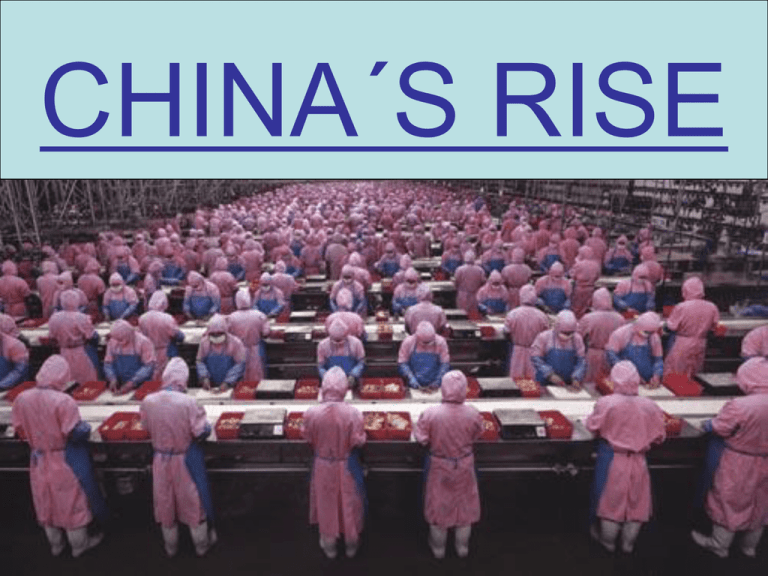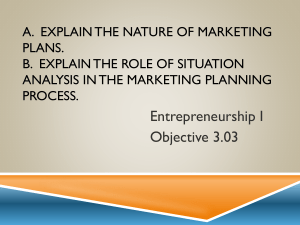China's Rise - Daniel Aaron Lazar
advertisement

CHINA´S RISE Is the economic rise of china, a threat to the western world? Joseph Nye: “If we treat China as the enemy, it will become the enemy because of how it perceives what we do.” Economical Threat? Trade • China's economy has grown at an average rate of 10 percent per year for the last fifteen years, the highest growth rate in the world • The staggering growth has lifted hundreds of millions out of poverty and transformed an agricultural society into one of the world's most dynamic, industrial markets. • Total trade in 2004 was more than $1.1 trillion, making China the world's third-largest trading nation, after the United States and Germany. • China today has the greatest openness to trade of any large economy • The United States is one of China's largest trading partners, and the two countries have managed their complex trade relationship: But tensions are still rising among U.S. officials over the U.S. trade deficit with China, $162 billion in 2004. The talk about Energy… • China's massive economic growth has caused a corresponding spike in its energy needs. Although much of the international world is focusing on China's increased consumption of oil, most of China's economy is actually run on coal. Some 67 percent of China's energy needs are met by coal, while only 24 percent of its energy consumption is oil. • China imported 117 million tons of oil last year, while Japan imported 200 million tons, and the Untied States and Europe imported 500 million tons each, according to the Chinese State Information Center. • China has invested more than $8 billion in Sudan, which now supplies over 7 percent of the nation's oil. Some 4,000 unofficial Chinese forces reportedly protect those resources. China has sunk another $70 billion into Iran's oil and gas industry, which now supplies 11 percent of China's energy needs.." Increases its influence Diplomacy • China and the United States are leading efforts to prevent North Korea from developing nuclear weapons. • China is actively pursuing a foreign policy of "peace and development to bring harmony, security, and prosperity to all," the official Xinhua News Service • In 1971, China had diplomatic relations with sixty countries; today, that number is 160. It In April 2005 alone, they visited Brunei, Indonesia, the Philippines, Pakistan, Bangladesh, Sri Lanka, and Indonesia. • Chinese officials have actively wooed new friends and allies. • With its confident new diplomatic posture, China is becoming more assertive. Recently, the SCO pushed the United States to withdraw its troops from Uzbekistan and Kyrgyzstan. Why the US sees china as a threat? First,reason ideological and have cultural factors The for American concern mainly Three different logics been arises from its status in the make China a hegemonic threat. constructed to substantiate the "China world politics and the and ideological Second, geopolitical geoeconomic threat" thesis. incompatibility of China with the Western factors. value system. Third, the collapse of China. China's Point of View • First, China's development depends upon and in return will contribute to the world peace; • Second, China will resort to peaceful means for development • Third, China's development will rely more on its own resources and market; • Fourth, China is prepared for a long-term process of hard work, even several generations, for economic prosperity. • Finally, even as China has achieved its economic development, it will not seek hegemony in the world or come out as a threat to any country. Military threat? •Beijing's official estimate of its military spending is currently between $30 billion A war with any country and $35 including billion dollars. the United States •Many independent analysts would threaten China'sput twothe real figure at greatest $50 billion to $65 billion. policy priorities, •The Pentagon's estimates, however, continuing strong economic growth and maintaining range from $70 billion to a high of $105 billion perinternal year. social stability. But what about the US? • In comparison, the U.S. defense budget for 2006 was about $420 billion (PDF), nearly half of the total global expenditure on defense, and roughly equal to the defense spending of the rest of the world combined. China As A Military and Political Threat A Second Cold War? Reasons for Distrust Incompability with western ideology? The clash of civilizations? (‘the unholy alliance between the islamic and Confucian cultures?’) US hegemony threatened: recent SinoRussian friendship The more legitimate reasons for distrust Recent increase in China’s military spendings Chinese attempts to buy US Oil Reserves (CNOOC – Unocal) Discouraging neibouring countries from harboring US bases (Uzbek. SCO) Chinese relationships with “problem countries”: Iran, Sudan, and Venezuela Better reasons for future distrust The establishment of the "Joint Statement of the U.S.-Japan Security Consultative Committee”. US-Japanese efforts to "encourage the peaceful resolution of issues concerning the Taiwan Strait through dialogue." Oil The Containment Policy Assertive Nationalism – “Century of Shame” Democracy, or lack thereof? At the moment 2,900,000 men 300-450 nuclear missiles (can produce +2500) Long- and mid-range missiles (8000km, 6500km) Total expenditure: 4% of U.S., 25% of Japan… But growing by two digits every year Though significantly weaker in absolute terms, critics suspect that China may prove stronger in relative terms 高技術條件下局部戰爭 大中華圈 .. The scary bit The repercussions Taiwan? North Korea? Another Arms Race? Loss of a huge market Tension around the eastern borders (Indian Armed Forces) Military or Environmental/Demographic Threat? Japan • China suffered several severe acts of aggression at the hands of the Japanese. • Currently Japan and China still haven’t developed a framework to solve their territorial disputes and their relationship has reached a low point. • The Chinese often suspect that U.S. and Japan are the originators of a variety of "China threat" arguments. • One of China’s principle of guiding of "China's peaceful rise,“ is neglecting Japan. • As China has successfully managed relationships with the sole superpower, the second-tier strategic partners, and neighbouring countries, China is able to afford to ignore Japan and occasionally show some toughness. • The official New China News Agency described the joint declaration as "unprecedented" and quoted a senior foreign ministry official as saying that China "resolutely opposes the United States and Japan in issuing any bilateral document concerning China's Taiwan, which meddles in the internal affairs of China and hurts China's sovereignty." Taiwan • Taiwanese are descendants of Chinese. The people who arrived in Taiwan around 1945 came from China. • In 1624, Dutch traders first claimed it their island for trade between China and Japan. Later on the Spanish settled there until they got kicked out. • “Taiwan has developed steadily into a major international trading power with nearly $427 billion in two-way trade (2006) and the world's 17th largest economy.” • From 1949 until 1991, the authorities on Taiwan claimed to be the legitimate government of all of China. • China replaced the United States as Taiwan's largest trade partner in 2003. Hong Kong Special Administrative Region • U.S. Exports to Hong Kong=17.8 billion dollars (2006) » 31.9 billion (2005)








